The chapter begins by examining the emergence of new religious and philosophical ideas, including early Buddhism and Jainism, highlighting their core tenets, such as the emphasis on non-violence, karma, and liberation, and their challenge to the established Brahmanical order. It discusses the lives and teachings of Buddha and Mahavira, as well as the early organization of monastic orders.
The rise of Brahmanism and the development of Puranic traditions are also explored, focusing on the integration of diverse local cults and deities, the importance of major gods like Vishnu, Shiva, and Durga, and the compilation of religious texts like the Puranas.
The chapter then shifts to architecture and sculpture, examining the early forms of Buddhist stupas (like Sanchi), rock-cut caves (like Ajanta and Ellora), and the beginnings of temple architecture.
Finally, the chapter touches upon the interaction and synthesis of different religious traditions, as well as the role of patronage from various rulers and communities in fostering these cultural developments. It emphasizes the dynamic and evolving nature of religious beliefs and practices during this transformative period.
Exercise
1. Were the ideas of the Upanishadic thinkers different from those of the fatalists and materialists? Give reasons for your answer.
Ans:
Upanishadic thinkers sought ultimate spiritual reality in the oneness of Atman and Brahman, stressing the principles of karma and rebirth, and the significance of knowledge as a path to liberation. Materialists (Lokayatas) adopted an empirical approach, denying the existence of an afterlife and prioritizing sensory enjoyment within the tangible realm.
The Upanishads concentrated on metaphysical inquiries and spiritual progression through understanding and righteous conduct. Fatalists viewed existence as rigidly predetermined, thereby dismissing individual autonomy. Materialists rejected any concept not directly perceivable through the senses, emphasizing the primacy of earthly life. These divergent perspectives on the nature of reality, the existence of free will, and the fundamental purpose of life underscore profound distinctions in their philosophical frameworks.
2. Summarise the central teachings of Jainism.
Ans:
The foundational principles for this path are non-violence (ahimsa) towards all living beings, truthfulness (satya) by avoiding all forms of falsehood, non-stealing (asteya) by not taking what is not freely given, celibacy (brahmacharya) through self-control over sensual indulgences, and non-possession (aparigraha) by limiting attachments to material things. Jainism emphasizes karma as a subtle matter that binds the soul, and liberation is attained by eliminating these accumulated karmas through right faith, right knowledge, and right conduct (the three jewels). The doctrine of anekantavada (non-absolutism) promotes understanding truth from multiple viewpoints, thereby encouraging tolerance.
In essence, Jainism advocates for liberation through spiritual purity achieved by the observance of non-violence, truthfulness, non-stealing, celibacy, and non-possession. It highlights the process of shedding karma through right faith, knowledge, and conduct, and the comprehension of truth from diverse perspectives (anekantavada).
3. Discuss the role of the begums of Bhopal in preserving the stupa at Sanchi.
Ans:
The Bhopal Begums, Shahjehan and Sultan Jahan, were pivotal in safeguarding the Sanchi stupa during a period of neglect. Shahjehan Begum initiated preservation efforts and provided crucial financial support, which attracted archaeological interest. Notably, she funded the establishment of a local museum to protect discovered artifacts and supported John Marshall’s scholarly publications on Sanchi, thus elevating its academic importance. Their timely financial and personal engagement ensured the stupa’s survival and facilitated its recognition as a vital historical and religious landmark.
4. Read this short inscription and answer: In the year 33 of the maharaja Huvishka (a Kushana ruler), in the first month of the hot season on the eighth day, a Bodhisatta was set up at Madhuvanaka by the bhikkhuni Dhanavati, the sister’s daughter of the bhikkhuni Buddhamita, who knows the Tipitaka, the female pupil of the bhikkhu Bala, who knows the Tipitaka, together with her father and mother.
(a) How did Dhanavati date her inscription?
(b) Why do you think she installed an image of the Bodhisatta?
(c) Who were the relatives she mentioned?
(d) What Buddhist text did she know?
(e) From whom did she learn this text?
Ans:
Here are the answers to your questions based on the inscription:
(a) How did Dhanavati date her inscription?
Dhanavati dated her inscription by referring to the regnal year of a specific ruler.
(b) Why do you think she installed an image of the Bodhisatta?
It is likely that Dhanavati installed the image of the Bodhisatta as an act of religious merit and devotion within the Buddhist tradition. Installing images of the Bodhisattva was a common practice for devotees to express their faith, seek spiritual benefits, and perhaps contribute to the spread of Buddhist teachings.
(c) Who were the relatives she mentioned?
The relatives Dhanavati mentioned were:
- Her father
- Her mother
- Her sister’s daughter (making Buddhamita her sister)
(d) What Buddhist text did she know?
The inscription states that the bhikkhuni Buddhamita “knows the Tipitaka.” While the inscription doesn’t explicitly say Dhanavati knew the Tipitaka, it highlights the scholarly background of her aunt.
(e) From whom did she learn this text?
The inscription doesn’t directly state who taught Dhanavati, but given the close relationship mentioned (niece of a Tipitaka scholar), it’s plausible she may have also learned from Buddhamita or been influenced by her knowledge.
5. Why do you think women and men joined the sangha?
Ans:
Facing neglect, the Bhopal Begums, Shahjehan and Sultan Jahan, crucially protected the Sanchi stupa. Shahjehan Begum started preservation with vital funds, drawing archaeological attention. Sultan Jahan Begum continued this, significantly funding upkeep and a local museum for artifacts, also supporting John Marshall’s Sanchi publications, boosting its academic standing. Their timely financial and personal involvement saved the stupa and aided its recognition as historically and religiously significant. John Marshall’s dedication of his Sanchi works to Sultan Jahan Begum highlights her key role, and the stupa’s good preservation today largely owes to their foresight and dedication.
6. To what extent does knowledge of Buddhist literature help in understanding the sculpture at Sanchi?
Ans:
While visually striking, the carvings’ narratives, symbols, and philosophical ideas derive directly from Buddhist texts like the Jataka tales, accounts of the Buddha’s life, and core doctrines. Jataka scenes illustrate karma and compassion. Panels depicting the Buddha’s life events gain meaning with knowledge of those narratives. Symbols like the wheel and lotus acquire significance through their textual associations. Without this literary context, the sculptures risk being seen as mere decoration, losing their profound narrative and doctrinal depth. Therefore, familiarity with Buddhist literature unlocks the intended meaning and spiritual significance of the Sanchi sculptures, offering a richer and more informed appreciation of the site.
7. Figs. 4.32 and 4.33 are two scenes from Sanchi. Describe what you see in each of them, focusing on the architecture, plants and animals, and the activities. Identify which one shows a rural scene and which an urban scene, giving reasons for your answer.
Ans:
Fig. 4.32 portrays a verdant environment with arched gateways and railings typical of early stupas. Abundant trees and animals, especially elephants linked to Buddhist narratives, dominate the scene. People on foot and possibly animals approach the gateway, creating an impression of a natural setting around a significant religious structure. This likely depicts a rural scene, emphasizing nature surrounding a religious site outside a major urban area.
Fig. 4.33 showcases densely packed, architecturally detailed structures suggesting dwellings in a settled area. While some vegetation exists, it’s less prominent than in Fig. 4.32. People engage in various activities within this built environment, indicating movement through an organized space. The complex architecture and high human activity density suggest a more developed settlement. This likely depicts an urban scene, characteristic of an early historic city with concentrated dwellings and human activity forming a social and economic hub.
8. Discuss the development in sculpture and architecture associated with the rise of Vaishnavism and Shaivism.
Ans:
The emergence of Vaishnavism and Shaivism around the early centuries CE spurred significant growth in sculpture and architecture, primarily focused on building temples for Vishnu and Shiva. Early temples were simple sanctums (garbhagriha), which gradually evolved to include towers (shikhara) and halls (mandapas).
Sculpture became central to these traditions. Vaishnava art depicted Vishnu and his avatars, often narrating Puranic tales. Shaiva art focused on Shiva, symbolized by the linga and also in human form with his attributes. Temple walls featured intricate carvings of these deities and related myths, serving devotional and educational purposes. The Gupta period saw a flourishing of this temple art, influencing later styles. Rock-cut architecture also developed, with caves transformed into Vishnu and Shiva shrines showcasing impressive sculptures.
9. Discuss how and why stupas were built.
Ans:
Early Buddhism saw the construction of stupas as vital structures, primarily functioning as sacred repositories for the Buddha’s relics, thus becoming potent sites for veneration. The act of building stupas was also considered a means of accruing merit, with contributions coming from various levels of society. Royal patronage, particularly during Ashoka’s reign, significantly propelled the widespread construction of these monuments.
Beyond housing relics, stupas evolved into symbolic representations of the Buddha and his teachings. Their architectural components carried symbolic significance, and the practice of circumambulation became a central devotional ritual. Consequently, stupas served not merely as physical containers of relics but also as powerful visual and architectural expressions of Buddhist faith, fostering devotion, facilitating ritual practices, and generating religious merit for those involved in their creation and veneration.


